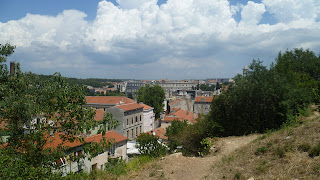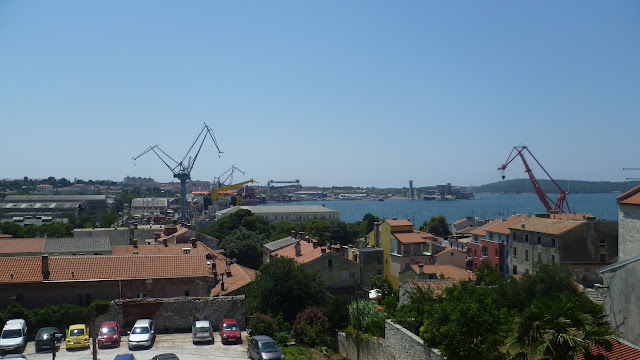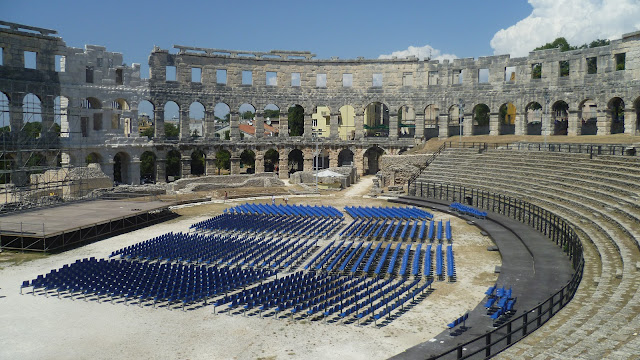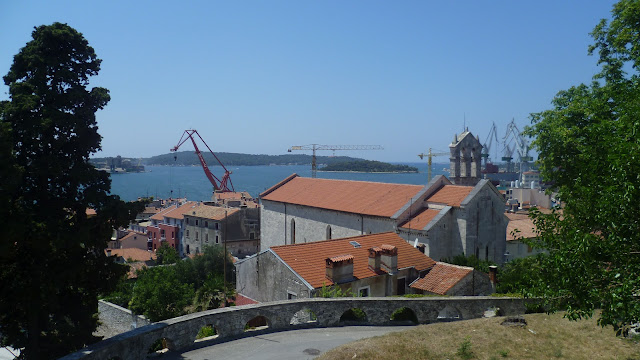Croatia 2012 - Istria
Istria was a National Geographic Top Ten tourist destination for 2011. This northern Croatian destination has everything you need for a great summer holiday, 32 degree weather, beautiful old towns and architecture, pristine Mediterranean water lapping onto rocky beaches. It’s an old watering hole of the Austro-Hungarian Empire where the well heeled would come to holiday, if you like, the Cote d’Azure of the Hapsburgs, and has close historical connections with Italy. Get ready for plenty of pizza and pasta!
Pula
Pula sits at the southern end of the Istrian peninsula, and is a workaday city which also packs a punch with tourists. It has that gritty feel of a city on the move, with shipbuilding a major industry, but it also heaves with visitors in the summer and makes for a great getaway. It’s also an ideal place to base yourself to explore the Istrian peninsula, even if you just trawl up and down the coast. Bear in mind that Croatia is only about 775 miles from the UK, compare that with the straight line distance from Lands End to John O’ Groats of 603m. Fly from Gatwick over Paris, then over the French, Swiss and Austrian Alps, afterwards over Venice and you’re descending into Pula. In fact you can get the bus quite easily between Venice and Pula.
 |
| View over arena |
The centre of Pula sits right on the waterfront looking out over a harbour enclosing substantial modern shipyards. The main holiday/beach areas lie a mile or two to the east on an indented coastline and are easily accessible by bus or even a brisk walk. The main sights in town, notably Roman remains, are easily reachable on foot in the town centre.
 |
| Shipyards in the centre of town! |
There is an excellent local bus service and I caught buses to Rovinj up the coast and Fazana to catch the ferry to Brijuni. I regularly caught the bus between the town centre and my lodgings near Verudela for 11 kuna single fare. Some bus drivers tend to move rather than drive and you may be in for a jerky ride, so hold on tight.
Accommodation – I landed at Pula, caught the bus into town, left my bag at left luggage at the bus station, and went and found a room slap bang in the centre, on the main walking street and directly above the restaurant area. I used a tourist office to book a room. For 30 euro you get a comfortable room with shared bathroom in a prime spot on Via Sergia, the main walking street to see and be seen. The proprietor was very friendly and helpful, and gives you tips on restaurants and so on. After a couple of days I upped sticks and headed towards the beach area hoping to find something a little better with ensuite facilities. Using a tourist office near Verudela. I found a room with ensuite facilities for 25 euro which works out at about £20. This was in a quiet residential area but adjacent to a supermarket, pharmacy and one or two cafes and restaurants.
The big cheese in Pula is the Roman Arena which you can see from the air as you fly in if you’re lucky. It is one of the six biggest in the world and the striking thing is that there is so much of it left. You must not miss a visit. It had a 25000 capacity and would have fitted with Pula being an important Roman regional centre. It’s literally on the edge of the city centre by an old Roman road, not far from the waterfront and you can walk around and wonder at its size, or even go in to investigate. It costs 40 kuna to get inside, and a further 30 kuna to get an audio tour of about twenty different points scattered around the stadium, giving you a history of the building and gladiators who fought within these walls. If you failed you were dead, but the top gladiators commanded very high pay. Wild beasts were hunted down and brought here to fight one another and to kill people. It’s still used as a major venue and has hosted music acts such as Jamaroquai, Sting, Elton John and even Tom Jones this August. I watched a little of a classical singing concert from outside the arena, you can look though the iron railings. A security guard stands just within to catch any interlopers, otherwise you could slip over the fence easily!
 |
| Pula Arena |

Despite the industrial feel Pula town centre is a wonderful place to wander around at any time of day. It has lots of old buildings, often a bit frayed round the edges, and also Roman remains in the vicinity, and walking streets bordered with shops, cafes and restaurants to keep you amused, and of course ice cream kiosks everywhere. There is a Roman Gate, the Arch of the Sergians, on one of the main squares, and by a little cafe overlooking the gate is a bronze statue of James Joyce, the famous Irish novelist who made Pula his home for a while – he has now been adopted by Pula! Joyce was here from 1904 to 1905 and worked as a Professor of English at the Berlitz school, teaching mainly Austro-Hungarian officers. You can sit next to him at a little cafe table and enjoy some people watching. From the arch Via Sergia swathes through the middle of town to reach the Roman Forum which I would class as the hub of the town. Fine classical buildings surround a substantial space, part of which is covered in tables and chairs tumbling out of the cafes and restaurants. Here also is the Temple of Augustus, pretty well preserved, which costs ten kuna to explore inside the bits of Roman remains, statues and suchlike.
Between the Roman Forum and the Arena is the cathedral which is also worth a visit, accompanied by a tower which sits just outside the main entrance.
 |
| Inside Temple of Augustus |
 |
| Roman forum |
 |
| Arch of the Sergians |
 |
| Temple of Augustus |
 |
| Amphihteatre remains |
Between the Roman Forum and the Arena is the cathedral which is also worth a visit, accompanied by a tower which sits just outside the main entrance.
Pula has a high point on which stands a large fortification complete with museum and cannons in keeping with its history as an important naval base. From the hill protruding from the city centre you get great views across the harbour, shipbuilding yards and not least the Arena.
 |
| Fortification atop Pula |
Pula environs are worth exploring. If you are a beach bum, go to Verudela, just a short bus journey from the town centre. Here the pine clad coast winds around little coves and beaches, backed by hotels and summer residences, and it’s a great place to enjoy the cleanest water in the Med. I visited Medulin as well, another family type resort along the coast, but don’t rate it as highly as Verudela which I thought had better beaches and all round ambience. You could quite easily spend a whole holiday just in this area.
 |
| Rocks at Verudela |
 |
| Verudela coastline |
National Geographic recommends its readers to visit Pula and its arena, the ‘remarkably intact first-century Roman amphitheatre,’ which ‘hosts numerous summer concerts and events.’
Rovinj
Rovinj could only be describes as Pula’s stately sister, 31km north up the coast. This is a pearl of a place to visit, with the old town on a little promontory sticking out into the Adriatic. It was part of the old Venetian possessions and has a very Italianate look, no surprise as Venice is just over the water. It sits on a hill topped by the St Euphemia’s Basilica, a huge church well worth a visit. Its tower dominates the skyline. There is a plaza surrounding the church on which you can admire the views out over the harbour and islands, and inside the church is airy, voluminous and richly decorated, with altars to various saints. There is a sarcophagus supposed to contain the remains of St Euphemia who was martyred by Diocletian. She was a young Christian that upset the Roman Empire, and on the wall alongside is a huge painting of the saint in an amphitheatre attracting the attention of a lion, with one or two bloodied bodies laying in the background and the crowd baying for more. Her sarcophagus as the story goes was eventually transported here to Rovinj, hence the church, and there is another huge painting of the sarcophagus arriving evidently at Rovinj by sea, with church dignitaries waiting to meet it on the beach and crowds gathering alongside.
 |
| Rovinj from harbour |
Rovinj could only be describes as Pula’s stately sister, 31km north up the coast. This is a pearl of a place to visit, with the old town on a little promontory sticking out into the Adriatic. It was part of the old Venetian possessions and has a very Italianate look, no surprise as Venice is just over the water. It sits on a hill topped by the St Euphemia’s Basilica, a huge church well worth a visit. Its tower dominates the skyline. There is a plaza surrounding the church on which you can admire the views out over the harbour and islands, and inside the church is airy, voluminous and richly decorated, with altars to various saints. There is a sarcophagus supposed to contain the remains of St Euphemia who was martyred by Diocletian. She was a young Christian that upset the Roman Empire, and on the wall alongside is a huge painting of the saint in an amphitheatre attracting the attention of a lion, with one or two bloodied bodies laying in the background and the crowd baying for more. Her sarcophagus as the story goes was eventually transported here to Rovinj, hence the church, and there is another huge painting of the sarcophagus arriving evidently at Rovinj by sea, with church dignitaries waiting to meet it on the beach and crowds gathering alongside.
For 15 kuna you can climb the bell tower, but this is quite a climb for anyone, as ladder type wooden steps constitute at least some of the stairs so you have to watch your footing, and there are a lot of steps! But it is well worth the effort as the views from the top are great across the old town and onto the mainland. Red slate roofs dominate the town, around is the harbour and marina, and the indented coastline winds in and out to the north and south, with boats ferrying between the islands and the mainland. You can also observe the three bells directly above you, the biggest being in the middle, and the viewing area is solid and spacious.
If you like wandering through ancient streets which wind up and down, and looking at little shops selling jewellery, artwork, clothes and trinkets, then this is the place for you. It all clusters around an attractive harbour backed by ancient buildings decorated in pastel blues, pinks and yellows. A great place for photographers. There is a museum on the seafront advertising an intriguing exhibition of medieval torture instruments, but unfortunately it was closed!
If you trace the harbour and marina to the south you get to the bathing areas backed by pine woods, there are snatches of intermittent beach intermingling with rocky platforms on which to plant your towel, and scratches of rock where you can make your own private beach. There is even a beach for dogs which is something Croatia caters for specifically.
There is a regular bus service between Pula and Rovinj. I caught the 1pm bus which takes about 45 minutes and cost 38k. The return journey at 21.55 was 43k and is somewhat quicker than the midday journey. This was the last bus back to Pula which gave me time to enjoy Rovinj. The bus station sits right on the edge of the main streets that run into town and to the waterfront. |
| Rovinj harbour |
 |
| Rovinj at dusk |
Fazana is a little town on the coast just about seven miles north of Pula which is your stopping off point for the ferry to Brijuni. It has an attractive centre straggling the waterfront and was pretty lively at night when I returned from Brijuni, and this was a Wednesday evening.
Brijuni
Brijuni is not to be missed. It is a gaggle of islands off the Istrian coast just north of Pula which form a National Park.This little set of diamonds would be the place where a James Bond villain would make his lair if they were a bit further out from the mainland! As it happens they were the retreat of Tito, the non aligned leader of ex-Yugoslavia where he conducted much of his political strategising and entertained countless world leaders and celebrities.
It’s kind of expensive to get onto the island, being a case of inelastic demand. You pay 210 kuna equally for two alternatives according to your taste. The charge pays for a fifteen minute boat trip each way, but you either do a four hour group tour including guide, museum trip, mini (tourist) train journey and safari trip, or you can stay as long as you like on the island and do your own thing, bearing in mind that the last boats of the day are 7.15pm and 9pm (Wednesday). Just don’t miss the last boat as the hotels look expensive! You can hire a bike for 105 kuna and go where you want on the excellent network of roads and tracks, although the bike I hired only had one gear!
Veli Brijun is the main island with most of the action. It is an attractive mix of parkland, rolling countryside, woodland and pine fringed sea shore, centred on a harbour backed by a couple of large hotels, and scattered buildings including churches, a souvenir shop, cafe and bike hire establishment. Tito had his house built on Vanga which lies to the west of Brijun, but that’s out of bounds.
 |
| Mediterranean Garden Brijuni |
Tito’s memory is everywhere. He liked animals, so there is a safari park. The Indian Prime Minister gave him the gift of an elephant, and now there is a statue of an elephant standing above the harbour. Also Koki the yellow crested cockatoo lives in a cage by the waterfront. He was given to a grandchild by Tito as a present and is destined to live to a great age (they can live to 100 years old). A building barely a few hundred yards from the boat pier houses a large collection of photographs of Tito and all the famous politicians and stars he entertained on these islands, including Queen Elizabeth. Sophia Loren and Gina Lollobrigida. He is made out to be a bit of a hero, a hail fellow well met, hob-nobbing with local fishermen, enjoying good wine, swimming and horseriding, and he supposedly loved meeting children. The ability to relate well to children can be the mark of a man, but he must have been a pretty tough guy to get to be the ruler of such a disparate group of nationalities.
 |
| Elephant statue |
There is also a golf course that mantles the northern part of the island just east of the safari park and running down to the sea. Herds of deer wander freely across the landscape. If you like beaches, most of the official ones are scattered down the north eastern coast of the island which is supposed to be excellent for snorkelling. You can find your own spot as well.
The safari park is entered by pressing a button which opens two large gates remotely. I did not see an awful lot of wildlife, some ostriches, zebras and the odd hump backed cow. No elephants, lions or tigers I'm afraid!
 |
| Safari park |
If you cycle south from the main port you come across the ruins of a Roman temple and also extensive remains of a Roman villa congregated around Uvala Verige, a large inlet from the sea. There is a long thin pier where you can do some private sunbathing.
 |
| Roman Temple |
 |
| Temple with villa in background |
Marshall Tito’s car is a must see, a 1953 Cadillac, a classic American roadster kept in pristine condition in its own little enclosure. Tito would use it to drive his guests around to enjoy the beauties of the island. It’s parked near the building showing the photo exhibition.
 |
| Cool car! |
There is other stuff on the island to see but I ran out of time. There is a place on the sea shore near the safari park where you can see dinosaur footprints, there are traces of a Neolithic settlement and a hilltop prehistoric settlement, a prehistoric tomb, a fort, and a cannon battery scattered around.
 |
| Brijuni - evening sets in |
Cape Kamenjak
 |
| Premantura |
Rent a bike for 70-80 euro for 24 hours to keep fit and tour the area. I rented a bike to visit Kamenjak, a little peninsula and nature reserve just south-east of Pula; apparently it’s a cool destination for the beach afficionados. I cycled from Verudela where I was renting a room, striking south until you reach the picturesque village of Premantura. By the time I got there I was ready for serious refreshment as I had been cycling a fair few miles, with a long incline near the end. I gratefully found shelter from the midday heat with a large lemonade in a village cafe. After buying a picnic lunch at the supermarket I headed for the entrance to the nature reserve which is just south of Premantura. There is a proper barrier entrance and you have to pay if you have a car, but bikes go free! Just watch for huge clouds of dust flying in your face as cars pass you on the rough trails. Cars should be banned from this area! There are roads for car use, but there are also bike tracks which are on the map but not terribly well marked. In the end you have to improvise, but be warned some of the tracks need very robust tires, I prayed continually that I would not get a puncture.The Kamenjak peninsula reserve is about two miles long and not even a mile wide, mostly flat or undulating. It is covered in grassland which provides a habitat for orchids, diverse plant life and also woodland, and has a winding indented coast most of the way round, with lots of little bays, although beaches are mostly stony. There are traces of dinosaurs on the west coast.
 |
| Kamenjak |
I found a huge swathe of rocky beach on the southern shore which attracted a large number of swimmers, sunbathers and snorkellers. It comprises proper rocky headland with sheer drops, and great sloping swathes of open rock which dip at awkward angles into the sea but provide plenty of towel space. You just have to find a relatively comfortable rock space if there is such a thing on which to place you towel. There were lots of cars parked at the top, together with toilets and a cafe.
 |
| Kamenjak coast |
This little peninsula is an important route for migrating birds. Toads, lizards and snakes can also be found.
 |
| View north over peninsula |
National Geographic quote: ‘an edge-of-the-world nature reserve featuring sheer 70-ft cliffs, hidden coves, and flat stone outcroppings nature-made for sunbathing.’
Sample of some typical Istrian prices 2012 (£1 = 9.6 kuna)
Cake – 6.50k
Two large waters plus chocolate croissant from supermarket – 15.30k
Lemonade – 10k
Seafood pasta plus coca-cola – 65k
Coffee at supermarket cafe – 8k
.
 |
| View over Kamenjak |
 |
| Tourist train on Brioni |
 |
| Koki the cockatoo |
 |
| Brioni waterfront |
 |
| Rovinj from Basilica |
 |
| Popular beach at Verudela |
 |
| Harbour at Verudela |







































